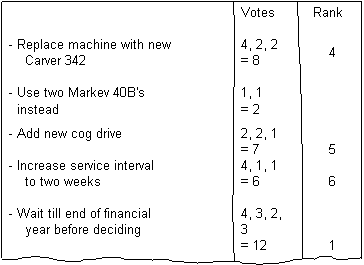Nominal Group Technique: How to do it
The Quality Toolbook >
Nominal Group Technique > How to do it
When to use it | How to understand it |
Example | How to do it | Practical
variations
<-- Previous |
Next -->
How to do it
- Identify the objective of the NGT session, writing it in a clear statement or question, for example 'How can we be sure customers know about product recalls?'
Note that if the need is to be strongly creative, it may be better to use Brainstorming rather than NGT.
- Recruit the group members for the meeting. Between them, they should have sufficient knowledge to be able to achieve the objective described in step 1.
If possible, get a facilitator to lead the NGT session. This is a person who has no stake in the outcome, other than to help the group meet their objective in a reasonable time-frame. In any case, ensure the meeting leader is familiar with the technique.
- In the meeting, clearly display the objective from step 1, for example by writing it on a whiteboard, and ensure everyone understands it.
- Silently
and privately, the team writes down their thoughts and ideas on 3" x 5" cards. When individuals have finished, they should wait quietly for others to finish.
- The leader collects the cards, shuffles them (to ensure individual people's ideas are not in batches), then reads them out, one at a time. If the idea is unclear, the team may discuss it, but only for clarification of meaning, not general debate.
The agreed final wording is then transcribed onto a flipchart or other surface that can be easily read by the whole team. If it is agreed that the point from a card has already been transcribed, then it need not be copied again.
- When all cards are transcribed and their meanings understood, vote on which
are to be selected. A guideline for the number of votes to use is given in Table
1, below. The value of each vote is governed by the number of votes that can be
cast. Thus, if there are four votes, the value of the votes are 4, 3, 2 and 1.
Voting is done by each member of the team, silently and privately writing down votes for the listed ideas. Each vote is written on a 3" x 5" card, along with the text of the item for which the vote is being cast.
Table 1. Example voting scheme
|
Number of ideas on list |
Number of votes per person |
Value of votes |
|
Less than 20 |
4 |
1, 2, 3 and 4 |
|
20 to 35 |
6 |
1, 2, 3, 4, 5 and 6 |
|
Over 35 |
8 |
1, 2, 3, 4, 5, 6, 7 and 8 |
- The leader collects the cards, shuffles them as before and writes the value of each vote against the appropriate idea on the displayed list. The rank order of the ideas is then written against each. The final list may thus appear something like this:

Fig. 1. Example ranking of ideas
- Review the results and discuss reactions to it. If there is no clear winner (for example, the top five ideas are within a few points of one another) or if there are strong objections, then a second round of voting may take place. This is done in the same way as the first voting session, but with the top ideas now transcribed again to a new sheet.
- Act upon the final selection.
<-- Previous |
Next -->
|